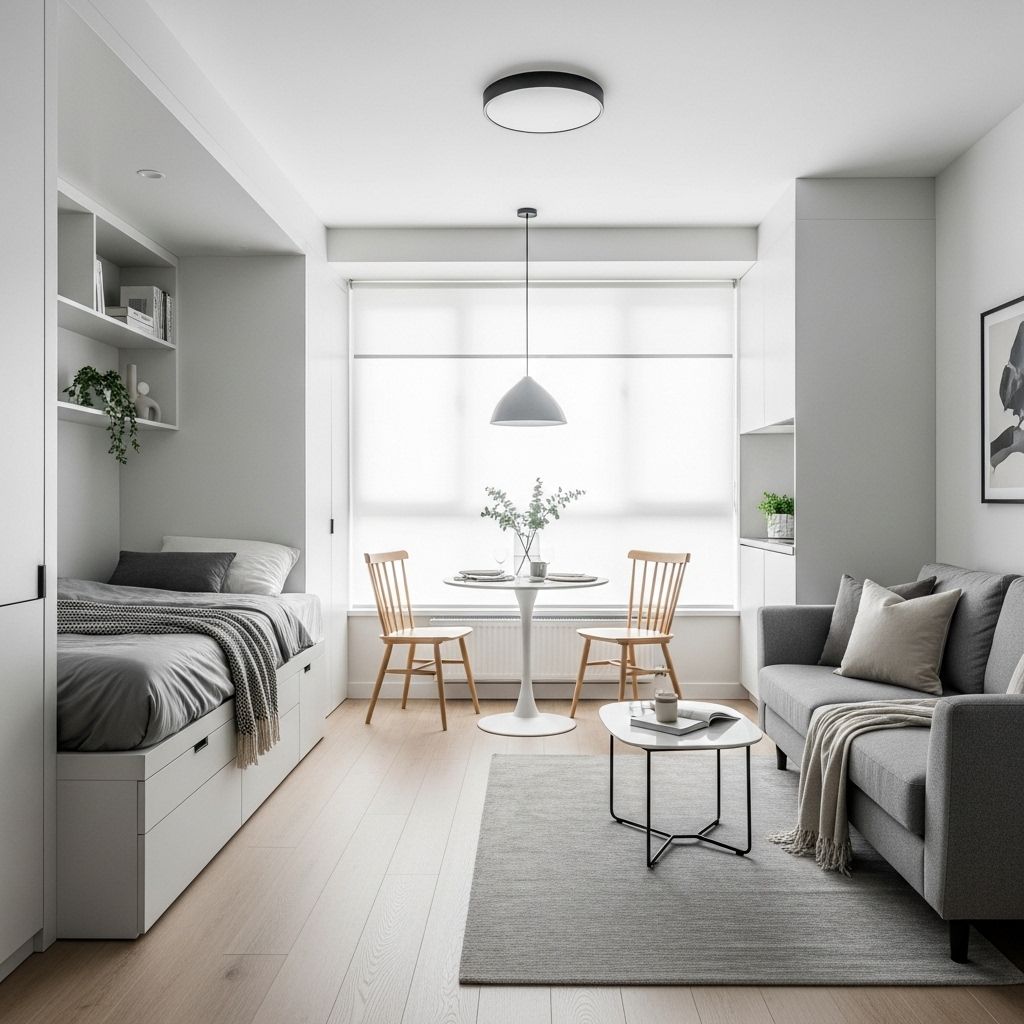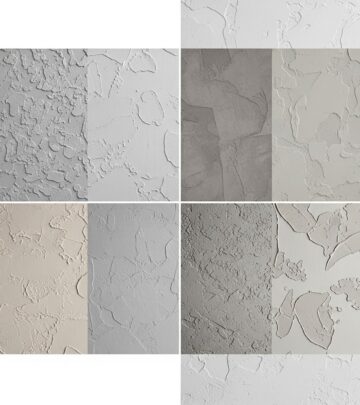Studio Apartment Layout Ideas: 13 Perfect Space-Saving Designs
Smart designs transforming compact living into chic, functional havens you'll adore.

Image: HearthJunction Design Team
13 Perfect Studio Apartment Layouts That Maximize Space and Style
Whether you’re living in a cozy city studio or downsizing to embrace minimalist living, making the most of a studio apartment comes down to creative layouts, multifunctional furnishings, and clever decor choices. This guide explores 13 inspiring studio apartment layouts, each with unique tips and ideas to help you transform your small space into a stylish, comfortable home.
1. Embrace a Loft Bed for Extra Space
If your studio has high ceilings, consider installing a loft bed. By elevating the sleeping area, you instantly gain usable square footage underneath for a workstation, seating, or even storage. An example is a 193-square-foot Scandinavian studio where lofted sleeping space and gallery-white walls create an airy feel. Built-in stairs with drawers ensure storage is never an afterthought.
- Lofted beds create vertical separation in small spaces.
- All-white color schemes visually expand tiny rooms.
- Staircases with built-in drawers offer valuable hidden storage.
- Always add secure handrails for safety.
2. Let Furniture Do Double Duty
Furniture that pulls double or even triple duty is essential in a studio. In a sub-190-square-foot railroad apartment, a bed that serves as a sofa helps carve out both living and sleeping zones without the need for extra seating. Accent pieces like a Moroccan rug and slender tables add warmth and function without overwhelming the room.
- Beds that convert into sofas or daybeds maximize floor space.
- Choose leggy furniture to maintain an open, airy look.
- Layer area rugs for coziness and subtle zone division.
3. Opt for Modular and Easy-to-Move Pieces
Fluid layouts are key for multi-purpose living. In a 350-square-foot studio, modular sofas and expanding coffee tables make it easy to reconfigure the space from living room to dining room. Hidden gems like a Murphy bed concealed within a storage wall take advantage of every inch.
- Modular sofas can adapt to seating or sleeping needs.
- Expanding tables provide dining space when needed, then tuck away.
- Murphy beds free up precious floor area during the day.
- Built-in storage walls keep clutter at bay.
4. Use Rugs to Define Zones
One of the simplest ways to segment a studio is with area rugs. Layering rugs or positioning them strategically helps visually separate bedroom, living, and dining areas without solid dividers. This tactic creates subtle room boundaries, making a single space feel like several distinct areas.
- Choose rugs in varying textures and colors for each zone.
- Rugs also add warmth and comfort underfoot.
- Match rug design to your color scheme for cohesion.
5. Choose a Bold Headboard as a Focal Point
In a studio where the bed is often visible from every angle, a statement headboard can double as art. A tall or uniquely shaped headboard anchors the sleeping area and gives the illusion of a separate bedroom space. Pair with minimal bedding and coordinated decor for a polished effect.
- Headboards can be upholstered, wood, or even a painted mural.
- Use wall-mounted sconces to free up nightstand space.
- Include a narrow shelf above the headboard for extra storage or decor.
6. Maximize Corners for Dining or Study Nooks
Make use of every corner by installing a petite dining or work nook. A wall-mounted drop-leaf table or slim desk fits neatly into unused space, providing a dedicated spot for meals or work. Stackable or folding chairs tuck away when not in use.
- Corner nooks create dedicated functions without crowding.
- Consider wall shelves above for additional storage.
- Choose lightweight, easy-to-move chairs.
7. Divide Space with Open Shelving
Open shelving units are a practical way to visually divide a studio without blocking light. Use shelves to subtly separate your sleep area from the living or kitchen zone while displaying books, plants, and curated decor collections.
- Open shelves allow light and air to flow between zones.
- Use baskets or bins for stylish concealed storage.
- Keep shelves organized to avoid visual clutter.
8. Install Sliding or Glass Room Dividers
For more privacy, consider lightweight sliding doors or glass partitions. These dividers delineate spaces while keeping the open feel that is essential in a studio. Frosted or ribbed glass provides privacy without sacrificing natural light.
- Sliding doors save space compared to swinging doors.
- Glass keeps sightlines open, creating the illusion of more room.
- Use curtains as a budget-friendly alternative to glass dividers.
9. Optimize Under-Bed Storage
Every inch matters when storage is scarce. Choose a bed with built-in drawers or raise your bed with risers to stash off-season items, shoes, or linens underneath. Storage baskets and bins can help keep contents accessible and neat.
- Drawer beds eliminate the need for additional dressers.
- Vacuum-sealed bags maximize under-bed capacity.
- Rolling bins make it easy to access stored items.
10. Decorate with Mirrors to Reflect Light
Strategically placed mirrors multiply natural light and visually double your space. Hang a large statement mirror or create a gallery of smaller mirrors to reflect sunlight from windows or lamps, instantly brightening the room.
- Mirrors make narrow spaces feel wider.
- Choose mirrored furniture for added shimmer.
- Lean a tall mirror on a wall for a casual, modern look.
11. Hang Curtains to Separate Sleeping Areas
If constructing a wall isn’t feasible, hanging curtains offers privacy and sound dampening for the sleep space. Floor-to-ceiling curtains across a section of your apartment act as a soft divider and can add texture and color to the room.
- Opt for ceiling-mounted tracks for a seamless look.
- Choose blackout curtains for added restfulness.
- Sheer curtains maintain light while offering some separation.
12. Install Wall-Mounted Furniture
Wall-mounted desks, fold-down tables, or floating shelves save valuable floor space in a small apartment. These features can be tucked away when not in use, making your studio flexible for work or entertaining.
- Floating desks double as entryway drop zones or vanities.
- Wall-mounted storage keeps essentials within reach, off surfaces.
- Choose slim, fold-down tables for occasional dining or work.
13. Keep It Minimal and Clutter-Free
Perhaps the most important rule for any small space: less is more. Choose essential, versatile furnishings and curate decorative accents carefully. Regularly edit what you keep on display to prevent the room from feeling crowded, and opt for closed storage when possible to reduce visual busyness.
- Stick to a cohesive color palette for unity.
- Limit decor to a few impactful pieces.
- Conceal clutter in storage ottomans, bins, or hidden cabinets.
Studio Apartment Layout Tips Table
| Tip | Benefit |
|---|---|
| Lofted Bed | Frees up floor space for seating or desks |
| Double-Duty Furniture | Maximizes functionality in tight quarters |
| Modular Pieces | Flexible for different uses (living, dining, sleeping) |
| Open Shelving | Maintains openness while dividing zones |
| Mirrors | Reflect light and visually expand the space |
| Sliding Dividers | Provides privacy without sacrificing light |
Frequently Asked Questions (FAQs)
How do you create separate zones in a studio apartment?
Use rugs, open shelving, room dividers, or curtains to visually divide the space. Zoning helps create the feel of multiple rooms within a single open-plan area.
What kind of furniture works best in a studio apartment?
Multifunctional pieces, such as sofa beds, modular sofas, and expandable tables, are ideal. Look for items that serve more than one purpose or can be easily moved and stored.
How can I add storage to my small apartment?
Maximize vertical space with wall-mounted shelves or lofted beds with built-in drawers. Use under-bed storage, hooks, and floating furniture to keep items off the floor.
Can a studio feel bigger than it is?
Yes! Light color palettes, strategic use of mirrors, minimal decor, and furniture with exposed legs all help studios feel brighter and more spacious.
What are quick ways to refresh a studio layout?
Rearrange furniture for better flow, swap or layer area rugs to redefine zones, or add new wall art to establish focal points without clutter.
References
- https://www.thespruce.com/perfect-studio-apartment-layouts-to-inspire-4124066
- https://www.thespruce.com/room-design-and-decorating-4127972
- https://www.youtube.com/watch?v=KYIlH31kV6Q
- https://www.pinterest.com/pin/922323198750259305/
- https://foyr.com/learn/studio-apartment-floor-plan-layout-and-decor-ideas
Read full bio of Shinta










